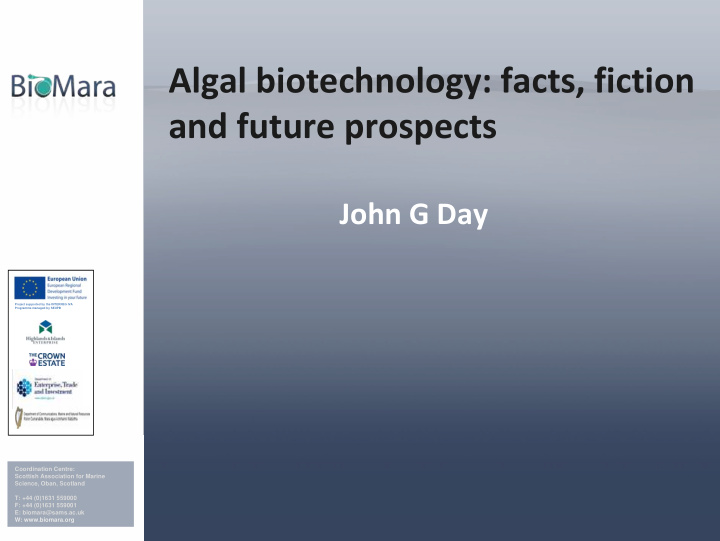



Algal biotechnology: facts, fiction and future prospects John G Day Project supported by the INTERREG IVA Programme managed by SEUPB Coordination Centre: Scottish Association for Marine Science, Oban, Scotland T: +44 (0)1631 559000 F: +44 (0)1631 559001 E: biomara@sams.ac.uk W: www.biomara.org
Why bother with Algae? • Algae are debatably the most diverse group of organisms on earth
Why bother with Algae? • Algae are responsible for the oxygen in every second breath you take • They form the basis of the food chain for approx 70% of the worlds biomass • Without algae the world dies!
If algae are such a big deal, how come we never hear about them?
Algal exploitation: Historical perspective Seaweed being harvested in 19th century for use as a fertiliser
Phyco ‐ colloids Agar 7,500 tonnes of agar with a wholesale value of US$250 million. Alginates >$120M excluding China Carrageenan > 50,000 tonnes in 2007/8 with a value of over US$600 million (excluding China)
Nori a $1 billion Industry More than 20 species are used in everyday cookery in Japan, six of them since the 8th century. Seaweed accounts for some 10% of the Japanese diet Most important food species in Japan are Nori ( Porphyra species), Kombu ( Laminaria species), and Wakame (Undaria pinnatifida)
Seaweed Products
What about Microalgae?
Historical use of algae: Food-supplement in central Africa & Central America Spirulina /Arthrospira
Aquaculture a multi- billion $ Industry • Chaetoceros calcitrans • Isochrysis sp. (Tahitian) • Nannochloris atomus • Pavlova luther i • Rhinomonas reticulata var. reticulata • Skeletonema costatum • Tetraselmis chui Thalassiosira pseudonana
Current uses of microalgae “Witchcraft” Dietary supplements Health foods Neutraceuticals Pigments & specialist chemicals
Microalgae & cyanobacteria COMMERCIALLY exploited and grown at large scale Chlorella spp Aphanizomenon flos aquae Arthrospira/ Spirulina spp Dunaliella salina Haematococcus pluvialis Cryptothecodinium cohenii
Production systems: Open
Production systems: closed
Future product areas • Biofuels • Foods • Bioactives/ Pharmaceuticals • Novel enzymes • Specialist chemicals • Green fertilizers • Green insecticides • Bioremediation
Bioactives: pharmaceuticals • They are, as yet, a largely unexploited biotechnological “treasure store ”
Constraints Technological constraints • Production systems engineering problems • Downstream processing/ product extraction/purification/formulation • Production strain productivity • Production strain stability Can you protect your IP? • Yes… Can you afford to defend challenges to your patents? • No… Can you protect your know-how by some other method? Do not forget the Convention on Biological Diversity (CBD) & the UN Convention on the Law of the Sea (UNCLOS)! • Are you a BioPirate?
Future prospects Algal production- parallels with penicillin production: March 14, 1942 the first patient was treated for streptococcal septicaemia with U.S.-made penicillin used half of the total supply produced. By Spring of 1944 the USA to produce 2.3 million doses in time for the invasion of Normandy. $1000/Kg $100/Kg $10/Kg $1/Kg c/Kg
Conclusions: There must be a market need. Production must be reliable AND COST EFFECTIVE. The technology must be robust and reliable. Ideally the technology should be a platform for a suite of products. The technology should be protectable. Get it right and……. $
Recommend
More recommend